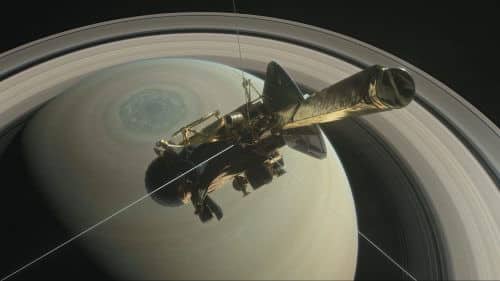This is according to a study that examined the data transmitted by Cassini during its passage through the plane of the rings shortly before it fell and burned up in Saturn's atmosphere

Almost forty years have passed since the Voyager 1 and 2 spacecraft visited the Saturn system. As the two spacecraft passed by the gas giant, they were able to capture some stunning high-resolution images of the planet's atmosphere, its many moons and the iconic ring system. An analysis of their findings showed even then that at the current rate of swallowing the material in the rings by Saturn, they would disappear within 100 million years, but the margin of error was too large to reach absolute figures.
The Cassini spacecraft recently stayed in the Saturn system and spent over 12 years exploring the planet, the moons and the ring systems. Naturally, she also collected a lot more data. According to a new study based on Cassini data, Saturn appears to be losing its rings at the maximum rate predicted from Voyager mission data. According to the aforementioned study, Saturn's rings are being swallowed by the gas giant at a rate that means they can disappear in less than 100 million years.
The research, which recently appeared in the journal Icarus, was led by James O'Donoghue of NASA's Goddard Space Flight Center and included members of NASA's Jet Propulsion Laboratory, the Center for Space Physics at the University of Leicester and University College London.
According to data obtained by the Voyager probes in 1980 and 1981, ice particles from Saturn's rings are pulled by the planet's gravity after reversing Saturn's magnetic field - which turns them into dusty "ring rain" in Saturn's upper atmosphere. . But as James Donahue pointed out in a NASA press release, the situation may be worse than originally suspected: According to data obtained by the Voyager spacecraft in 1980 and 1981, ice particles from Saturn's rings are being pulled by the planet's gravity. As they pass through Saturn's magnetic field, they are thrown into a shower of dust in Saturn's upper atmosphere, but according to O'Donoghue the situation may be even worse than initially estimated.
"We estimate that this "rain" drains an amount of water that can fill an Olympic-sized swimming pool from Saturn's rings in half an hour. From this figure alone, the entire ring system will disappear in 300 million years, but to add the ring material that, according to Cassini measurements, falls into Saturn's equator, the lifetime of the rings drops to 100 million years.
Cassini observed the loss of Saturn's ring material as part of its grand finale, in which the spacecraft exhausted its remaining fuel and passed between Saturn and its rings. It was a huge achievement, Cassini did what no other spacecraft has done, and it's certainly not worth putting an active spacecraft at risk.
Nevertheless, Cassini was able to obtain information that confirms the Voyager spacecraft's observations decades ago, and also provided an answer to the ancient riddle of Saturn's rings. Scientists have debated whether Saturn formed with the rings or acquired them at a later time. The new study indicates that the second scenario is highly likely, and that Saturn got its rings a short time ago in cosmic terms.
"We are fortunate to be here and see Saturn's ring system, which appears to be now in its middle age. However, if the rings are temporary, we may have just missed an opportunity to observe a huge ring system on Jupiter, Uranus-Uranus and Neptune-Rahab, which have sparse rings today." O'Dono concluded.
More of the topic in Hayadan:

One response
In practice, Saturn's rings will disappear within 10,000 years, by tourists taking souvenirs.